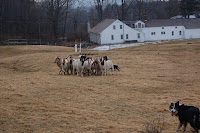Introduction
The following is an example of the method I use to introduce pups and start dogs working livestock. It is important to note that both pups do respond to a call off signal, part of the working relationship training that began as soon as the pups could walk.
The goats are presented to the pups by mentor dogs, under my direction. The pups are not being asked to do anything. The goats are presented in a manner that will bring out instinct and natural ability of the pups. The only words directed to the pups are "ahh", "that will do" and "here".
~~~
On this snowless February day, Zinc, a black and white male, and Neko, a red and white female, have just turned three months old. Today they will be introduced to livestock with two mentor dogs trained for such responsibility.
Please click on the photos for optimal viewing
In the first photo, the pups follow Rua and Em, with interest and excitement, as they drive twenty goats north, across the field.
In the second photo the pups are a little more apprehensive as they realize they are out of the safety zone I have always provided them. Once again, the foundation of the working relationship is seen as the pups defer to me for information and leadership.
 |
This is a great photo of potential to make note of. Both pups are carrying themselves in a working manner, just as the adults. Although it is too soon to be sure of the type of working dog, if any, the pup may become, it is important to recognize and acknowledge potential when we see it. We as handlers have a choice to nurture or diminish behaviors our dogs present.
As you see here and will see in the following photos, the pups often mirror the behavior of the adult dogs. This too I take great advantage of. In particular, I want the pups to be able to be quiet around the livestock. The by products of constant movement and frenzy is weakness and stress. Through acquiring a calm demeanor, the pups will learn more quickly and gain inner strength and confidence.
This photo shows the pups beginning to flank the herd as we take up the drive again. I like the way the pups are feeling their way around the goats' flight zone.
Here, I have just flanked the dogs around to the far side of the goats to change their direction, now facing the direction the pups were coming from. As the older dogs did this, the pups slowed down and pulled back. I then immediately called Rua and Em in between the pups and goats and told them to hold. The pups are once again mirroring their mentors as they stand and hold.
The dogs and pups were told "that will do", in this case meaning, leave the goats alone and allow them to wander back toward the south end of the field. The pups were then called back to me. A prime time to reinforce a call off is when energy is low.
In this photo I allowed Zinc to accompany Emma, just outside the picture, as she pushed the goats off a short ways.
After calling Zinc off, Neko was allowed to bring the goats back with Rua, in the picture but behind the goats.
A few minutes were given to having the mentors push the goats forward and then backing off to allow the pups to feel the livestock. The pups need the opportunity to learn what reactions their actions will cause.
If you look closely at this picture you will see Neko quickly escaping as RuaBinn dives in to thwart the goats challenge towards the pup. It doesn't take the goats, or any livestock, long to recognize the lack of knowledge, skill or heart of a pup, dog or human. It is important to be able to protect the pup or dog in training.
This is another example of the goats displaying threatening body language and Rua being called in to protect the pups. The pups are being protected but they are also learning what the threatening body language means and how to handle it.
In this very next photo, the pups join in on pushing the goats back. They are gaining knowledge and confidence.
One day Neko may be as big of heart, knowledge and confidence as her grandmother, RuaBinn.
Following another short break, we continued our drive back to the south field.
Once in the field, I slowed everything down again. Notice how the pups are following the slow movement of Em and Rua. The dogs were then told to hold and the pups stopped as well. We took another break. We take lots of breaks. The goats were allowed to wander off. The dogs went for water.
This series of photos is fun. Rua and Neko were still in the irrigation ditch soaking up water. Em and Zinc had returned to me. Zinc's body language indicated he had serious business in mind so I allowed him access to the goats. He went around them nicely and got to the balance point to push them. When he realized he was going to lose them, he flanked around to the front to stop them. Pretty impressive.
Some of the best work you will get from your dogs is from behaviors offered. Too often people get so hung up on obedience that they miss opportunities like this.
We ended this session with Rua and Emma settling the goats on the hill, and "that will do", lie down.
Before long the pups will begin to mirror their mentors and offer the lie down.






















